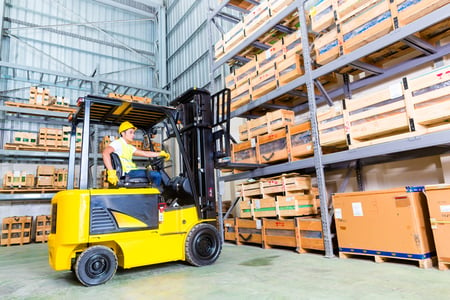 Forklift safety is a vital consideration for any material handling organization that uses these vehicles. According to Occupational Safety and Health Administration records, there were 63 serious accidents involving forklifts in 2020 alone.
Forklift safety is a vital consideration for any material handling organization that uses these vehicles. According to Occupational Safety and Health Administration records, there were 63 serious accidents involving forklifts in 2020 alone.
The potential ways people can be hurt or killed around forklifts — in a forklift accident such as an unstable load slipping, vehicles overturning and falling from elevation, a vehicle striking a pedestrian — are numerous. To protect workers against accidents like these, it's essential to meet and exceed OSHA regulations around forklift use.
Forklift safety: OSHA guideline compliance and beyond
The fact that OSHA maintains specific standards and regulations for forklifts shows just how important it is to focus on the safety of these powered industrial truck assets.
Some of the OSHA regulations deal with fundamental forklift deployment and use. For instance, each forklift vehicle is assigned a classification. Some of these classes are not authorized for use in certain environments, such as locations containing hazardous substances or powered equipment.
Top 7 forklift safety areas to check
1. Brakes
You can't call your forklift truck safe if it doesn't have an effective method of stopping. Functioning brakes are required by law on powered vehicles, and each forklift operator must test their brakes as part of their beginning-of-shift safety inspections. This means the brakes, brake pads and brake lights must all be functional, or else the forklift needs to be pulled from service until they're fixed.
2. Seatbelts
Seatbelts are required in forklift vehicles, as part of a standard affecting all forklifts manufactured since 1992. The Centers for Disease Control and Prevention advises all forklift operators to use seatbelts whenever they're available. In an accident such as a tip-over, a seatbelt could be the device that saves a driver's life.
3. Overhead guards
OSHA notes that overhead guards are there to protect operators from smaller falling loads such as boxed and bagged material. With that said, OSHA also calls on each forklift driver to wear a hard hat for extra protection. The overhead guard should be inspected at the beginning of every shift as part of the safety check.
4. Lights
Forklift vehicles should, per OSHA, have directional lights when operating in environments less than 2 lumens per square foot. An OSHA rule interpretation added that while additional lights such as flashing back-up lights are not required, they can serve as a device to limit struck-by risks.
5. Horn
Forklifts must be equipped with some noise-producing device, controlled by the operator, to provide auditory warnings to pedestrians and other drivers. This is especially useful when taking a blind corner. Backup alarms are also useful for guarding against pedestrian collisions.
6. Forks
The lifting fork on a forklift needs to be inspected as part of the vehicle's regular safety check-up. Why? Because even slight wear can limit lifting ability. This, in turn, can cause operators to misjudge how large a load the vehicle can handle, potentially leading to an accident. Forks should be replaced at 10% wear.
7. Chains
Chains are perhaps even more overlooked than forks when it comes to inspecting equipment. As an essential part of the mast, chains should be checked just as much as other safety features — a broken chain could lead to a potentially deadly load falling.
Forklift safety training: Operator training and pedestrian safety
Good forklift equipment is only part of the picture when it comes to forklift safety. Both operators and pedestrians in material handling areas should be trained on how to work with these assets.
Operators should note that being approved to drive one type of forklift in a single environment does not mean a person is approved for all vehicles in all settings. Per OSHA regulation, an employer must train workers, certify that they have received the necessary instruction and evaluate the worker's performance, all prior to the operator driving the powered truck.
Changes in workplace conditions and assignment to a different kind of forklift require refresher training. These additional safe operation courses are also necessary when an operator has been in an accident or near-miss, has been observed working unsafely or has received an employee evaluation that indicates unsafe conduct.
One potentially overlooked part of proper training involves pedestrian traffic, and preparing employees who work on the warehouse floor to work side-by-side with forklifts. It's easy to overestimate how quickly a truck can stop, how narrowly it can turn or how much visibility the operator has, which can lead to a serious accident.
Forklift safety and facility maintenance
When forklift safety is part of a facility's proactive maintenance strategy, that business is better prepared to prevent accidents of all kinds.
More comprehensive upkeep for the building itself can also go into protecting operators and pedestrians alike. Considerations such as installing mirrors on blind corners, implementing better overhead lighting and keeping pathways clearly divided between vehicle lanes and pedestrian walkways can make drivers' jobs simpler and safer.
Forklift maintenance and fleet upkeep is available as part of an overall proactive maintenance strategy, and can even be handled by a dedicated on-site technician. Reach out to learn more.
Case study: Keeping Campbell's equipment running with data-driven maintenance


 Ryan Lynch
Ryan Lynch